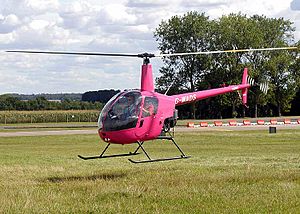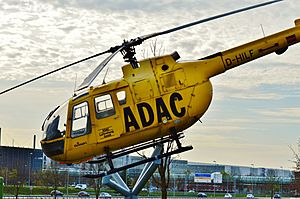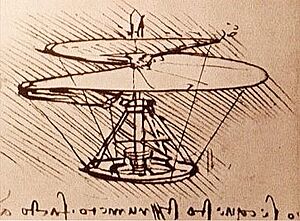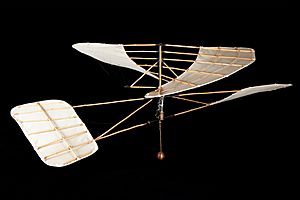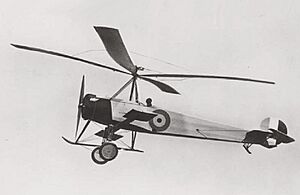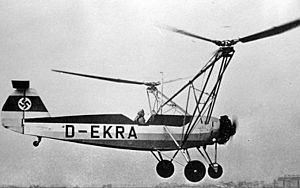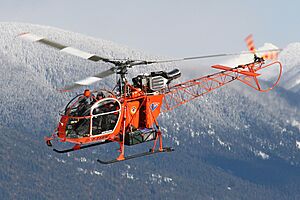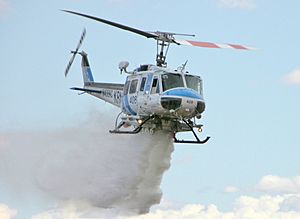Helicopter facts for kids
A helicopter (sometimes called a chopper or heli) is a type of flying machine or aircraft. Helicopters get off the ground and move using their rotors. A rotor is made of several small wings, called rotor blades, that spin around a central pole. This is why helicopters are also known as rotary-wing aircraft.
Helicopters fly differently from airplanes. An airplane needs to move forward to stay in the air, but a helicopter's spinning rotor blades allow it to stop and stay in one place above the ground. This means helicopters can land in many places where airplanes cannot. Helicopters can move by tilting their rotor blades, which makes the aircraft fly in that direction.
Contents
History of Helicopters
Early Ideas and Designs
The first ideas for vertical flight came from China. As far back as 400 BC, Chinese children played with bamboo flying toys. This toy, called a bamboo-copter, spins when you roll a stick attached to a rotor. The spinning creates lift, making the toy fly. An old Chinese book from the 4th century AD, Baopuzi, even talked about ideas similar to rotary-wing aircraft.
Later, in the 18th and 19th centuries, Western scientists created flying machines based on this Chinese toy.
Around the 1480s, the Italian genius Leonardo da Vinci designed a machine that looked like an "aerial screw". His notes suggest he built small models, but there was no way to stop the whole machine from spinning with the rotor. As science grew, people kept trying to achieve vertical flight.
In 1754, Russian scientist Mikhail Lomonosov showed a small model helicopter powered by a spring. It was meant to lift weather tools. In 1783, Christian de Launoy and Bienvenu used turkey feathers as rotor blades for their model. Sir George Cayley, inspired by the Chinese flying toy, also made models with feathers and later with tin sheets. His work greatly influenced future aviation pioneers.
Alphonse Pénaud made model helicopters powered by rubber bands in 1870. One of these toys, given to the Wright brothers by their father, inspired them to pursue the dream of flight.
In 1861, the word "helicopter" was created by Gustave de Ponton d'Amécourt, a French inventor. He showed a small model powered by steam, but it never lifted off the ground. However, his word "helicopter" stuck! Other inventors also used steam power. In 1877, Italian engineer Enrico Forlanini built an unmanned helicopter powered by a steam engine. It flew up 13 meters (43 feet) and stayed there for 20 seconds.
In 1901, Hermann Ganswindt's helicopter made its first flight in Berlin. This was likely the first motor-driven flight carrying people.
In 1885, Thomas Edison tried to build a helicopter. His experiments led to explosions and injuries. He realized a powerful, light engine was needed. In 1901, Ján Bahýľ, a Slovak inventor, used an internal combustion engine to power his helicopter model. It flew 0.5 meters (1.6 feet) high. By 1905, his helicopter reached 4 meters (13 feet) and flew over 1,500 meters (4,900 feet).
First Manned Flights
In 1906, French brothers Jacques and Louis Breguet began working on helicopters. In 1907, their Gyroplane No.1 lifted its pilot about 0.6 metres (2 ft) into the air for a minute. However, it was very unstable and needed people to hold it steady. So, it was the first manned helicopter flight, but not a free flight.
That same year, French inventor Paul Cornu built the Cornu helicopter. It had two large counter-rotating rotors powered by a 24 hp (18 kW) engine. On November 13, 1907, it lifted its inventor 0.3 metres (1 ft) and stayed up for 20 seconds. This was reported as the first truly free flight with a pilot. Cornu's helicopter flew a few more times but was unstable.
In 1912, Danish inventor Jacob Ellehammer built the Ellehammer helicopter. It made several free take-offs. During World War I, Austria-Hungary also developed an experimental helicopter, the PKZ.
Early Helicopter Development
In the early 1920s, Argentine Raúl Pateras-Pescara showed one of the first successful uses of "cyclic pitch." This allowed the rotor blades to change their angle as they spun, helping the helicopter move forward without a separate propeller. He also showed how a helicopter could land safely if the engine failed, using a method called autorotation.
In 1923, Thomas Edison congratulated George de Bothezat for a successful helicopter test flight. De Bothezat's helicopter stayed airborne for 2 minutes and 45 seconds at 15 feet (4.6 meters).
On April 14, 1924, Frenchman Étienne Oehmichen set the first helicopter world record recognized by the FAI (Fédération Aéronautique Internationale), flying his quadrotor helicopter 360 meters (1,180 ft). A few days later, Pescara broke this record, flying 736 meters (2,415 ft).
In 1925, Dutch engineer Albert Gillis von Baumhauer's helicopter prototype "hopped" and hovered. He invented the "cyclic and collective" controls, which are still used in helicopters today.
In 1927, Engelbert Zaschka from Germany built a helicopter that used a gyroscope to make it more stable. It could rise, descend, and stay still at any height.
In 1930, Italian engineer Corradino D'Ascanio built his D'AT3, a coaxial helicopter with two counter-rotating rotors. It set modest records for speed, altitude, and flight duration.
First Practical Rotorcraft
Spanish engineer Juan de la Cierva invented the autogyro in the early 1920s. This was the first practical rotorcraft. In 1928, de la Cierva successfully flew an autogyro across the English Channel. Autogyros were even used to deliver mail and newspapers before helicopters became common. Although autogyros couldn't truly hover, their development helped a lot with understanding how helicopters work.
Single Lift-Rotor Success
In the Soviet Union, Boris N. Yuriev and Alexei M. Cheremukhin built and flew the TsAGI 1-EA helicopter in 1932. It used a single main rotor and small anti-torque rotors at the front and back. Cheremukhin flew it to an unofficial altitude of 605 meters (1,985 feet), breaking earlier records.
In 1933, Russian engineer Nicolas Florine built the first helicopter with two rotors placed one behind the other (tandem rotors) that could fly freely. It reached six meters (20 feet) and stayed airborne for eight minutes.
The Bréguet-Dorand Gyroplane Laboratoire was a coaxial helicopter built in 1933. It first flew in 1935 and quickly set records. In 1936, it set a height record of 158 meters (518 feet) and a flight duration record of one hour, two minutes, and 50 seconds.
American Single-Rotor Beginnings
American inventor Arthur M. Young started working on model helicopters in 1928. He invented the stabilizer bar, which helps keep helicopters steady. In 1941, he joined Bell Aircraft and helped build the first Bell Model 1, which led to the famous Bell 47.
The Helicopter Industry Begins
Heinrich Focke designed the world's first practical helicopter, the Focke-Wulf Fw 61, which first flew in June 1936. It set several records for altitude, distance, and speed.
During World War II, Nazi Germany used helicopters for observation, transport, and medical help. The Flettner Fl 282 Kolibri was used in the Baltic, Mediterranean, and Aegean Seas. The Focke-Achgelis Fa 223 Drache was the largest helicopter of the war. However, Allied bombing stopped Germany from making many helicopters.
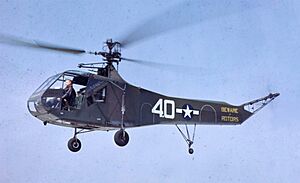
In the United States, Russian-born engineer Igor Sikorsky developed a simpler, single-rotor design, the VS-300 in 1939. This became the first practical single-rotor helicopter. To stop the helicopter from spinning due to the main rotor's torque, Sikorsky added a smaller rotor on the tail.
The R-4 of 1942, developed from the VS-300, was the first mass-produced helicopter. It was the only Allied helicopter used in World War II, mainly for search and rescue in tough areas like Burma and Alaska. Sikorsky produced over 400 helicopters by the end of the war.
Meanwhile, Bell Aircraft developed the Bell 47 in 1945, which became the first helicopter approved for civilian use in the United States in 1946. The Bell 47 was very popular for almost 30 years.
The Turbine Age
In 1951, Charles Kaman changed his K-225 helicopter to use a new type of engine: the turboshaft engine. This engine, a type of gas turbine, gave helicopters a lot of power without being too heavy. On December 11, 1951, the Kaman K-225 became the world's first turbine-powered helicopter. The Sud Aviation Alouette II was the first helicopter to be produced with a turbine engine.
Helicopters that could hover steadily took longer to develop than airplanes. This was because they needed very powerful engines for their weight. Improvements in engines and fuels in the 20th century were key. Today, while smaller helicopters still use piston engines, turboshaft engines are the most common choice for helicopters.
How Helicopters Fly
There are three main ways a helicopter flies: hovering, moving forward, and changing between the two.
Hovering
Hovering is the hardest part of flying a helicopter. This is because the helicopter creates its own windy air while hovering, which pushes against the body of the aircraft. The pilot has to constantly make small adjustments to keep the helicopter in place.
To hover, the pilot uses:
- The cyclic to control movement forward, backward, left, and right.
- The collective to control height.
- The pedals to control the direction the nose of the helicopter points.
All these controls affect each other, making hovering a constant balancing act.
Changing from Hover to Forward Flight
As a helicopter moves from hovering to flying forward, it gets extra lift without needing more power. This usually happens when the helicopter reaches a speed of about 16–24 knots (about 18-28 mph). This extra lift can be important for the helicopter to take off.
Forward Flight
When flying forward, a helicopter's controls work more like an airplane's.
- Pushing the cyclic forward makes the nose go down, increasing speed and losing height.
- Pulling the cyclic back makes the nose go up, slowing down and climbing.
- Increasing the collective (power) while keeping speed constant makes the helicopter climb.
- Decreasing the collective makes it descend.
By using these controls together, pilots can change speed while staying at the same height. The pedals help keep the helicopter flying straight, just like in an airplane.
Uses of Helicopters
Helicopters are very useful, especially during disasters. They can drop food, water, medicine, and clothes to people who can't be reached by roads. When people are hurt, helicopters can take them to hospitals faster than an ambulance on the ground.
The military also uses helicopters to move soldiers and equipment to places airplanes can't reach. Attack helicopters carry and fire guns and missiles.
Safety of Helicopters
Maximum Speed Limit

Helicopters cannot fly as fast as airplanes for several reasons. 1. Blade Speed: When a helicopter flies forward, the rotor blade moving forward (the "advancing blade") moves much faster through the air than the helicopter itself. This blade can even reach the speed of sound, causing a lot of drag and vibration. 2. Lift Imbalance: At the same time, the blade moving backward (the "retreating blade") moves slower and produces less lift. If the helicopter goes too fast, the retreating blade might not produce any lift at all. This creates a huge imbalance that can cause the helicopter to lose control. Helicopters with two main rotors that spin in opposite directions (like the Kamov Ka-50) avoid this problem because they always have balanced forces. 3. Blade Flapping: Rotor blades are designed to "flap" (lift and twist) to balance the lift. But at high speeds, they can flap too much, and the retreating blade can "stall" (lose lift).
Because of these issues, helicopters have a maximum safe forward speed called VNE, which means "velocity, never exceed."
Noise
By the end of the 20th century, designers started working on making helicopters quieter. People in cities often dislike noisy aircraft, so police and passenger helicopters can be unpopular because of their sound.
Vibration
Helicopters need careful adjustments to reduce vibration. A helicopter that is not adjusted correctly can vibrate so much that it shakes itself apart. Adjustments are made to the height and weight of the rotor blades. Many helicopters also have special parts called vibration dampers. Some even use systems that sense vibration and actively counter it.
Too much vibration can be very bad for a pilot, causing pain, numbness, and difficulty using their hands.
Loss of Tail-Rotor Effectiveness (LTE)
For helicopters with a single main rotor, the main rotor blades create spinning air currents called vortices. When hovering with a crosswind, or moving diagonally, these spinning air currents can hit the tail rotor. If the air currents spin in the same direction as the tail rotor, it can lose thrust, making it harder to control the helicopter's nose direction. Pilots use the foot pedals to adjust the tail rotor and fix this.
Hazards
Like any vehicle, helicopters can be dangerous if not operated safely. Here are some potential hazards:
- Settling with power: When the helicopter doesn't have enough power to stop its descent.
- Vortex ring state: A dangerous situation where the helicopter sinks into its own disturbed air, and adding more power makes it worse.
- Retreating blade stall: Happens at high speeds when the retreating blade loses lift, limiting the helicopter's top speed.
- Ground resonance: A strong vibration that can happen when the rotor blades are not evenly spaced.
- Dynamic rollover: When the helicopter tips over on its side, often during takeoff or landing.
- Powertrain failures: Problems with the engine or gears that can be very dangerous.
- Tail rotor failures: When the tail rotor stops working correctly, leading to loss of control.
- Brownout or whiteout: When dust (brownout) or snow (whiteout) stirred up by the rotors makes it impossible for the pilot to see.
- Low rotor RPM: When the engine can't spin the blades fast enough to stay in the air.
- Wire and tree strikes: Hitting wires or trees when flying low or landing in remote areas.
- Controlled flight into terrain: When the pilot accidentally flies the helicopter into the ground because they don't know where they are.
World Records for Helicopters
| Record type | Record | Helicopter | Pilot(s) | Date | Location |
|---|---|---|---|---|---|
| Speed | 400.87 km/h (249.09 mph) | Westland Lynx | John Trevor Egginton (UK) | 11 August 1986 | UK |
| Distance without landing | 3,561.55 km (2,213.04 mi) | Hughes YOH-6A | Robert G. Ferry (USA) | 6 April 1966 | United States |
| Around-the-world speed | 136.7 km/h (84.9 mph) | Agusta A109S Grand | Scott Kasprowicz (USA) | 18 August 2008 | From and to New York City |
| Highest altitude without payload | 12,442 m (40,820 ft) | Aerospatiale Lama | Jean Boulet (France) | 21 June 1972 | France |
| Highest level flight altitude | 11,010 m (36,120 ft) | Sikorsky CH-54 Tarhe | James K. Church | 4 November 1971 | United States |
| Altitude with 40-tonne payload | 2,255 m (7,398 ft) | Mil V-12 | Vasily Kolochenko, et al. | 6 August 1969 | USSR |
| Highest takeoff (turbine) | 8,848 m (29,029 ft) | Eurocopter AS350 | Didier Delsalle | 14 May 2005 | Nepal |
| Highest takeoff (piston) | 4,300.7 m (14,110 ft) | Robinson R44 | Mark Young | 12 October 2009 | United States |
| First manned electric flight | Purely electric hover | Solution F Prototype | Pascal Chretien | 12 August 2011 | France |
| Longest human-powered lift | Pedalling, lift 64 s endurance, 3.3 m height | AeroVelo Atlas, 4 rotors | Todd Reichert | 13 June 2013 | Canada |
Images for kids
-
An HH-65 helicopter doing rescue hoist training
-
KPRC's Bell 206 helicopter providing aerial news coverage
See also
 In Spanish: Helicóptero para niños
In Spanish: Helicóptero para niños


